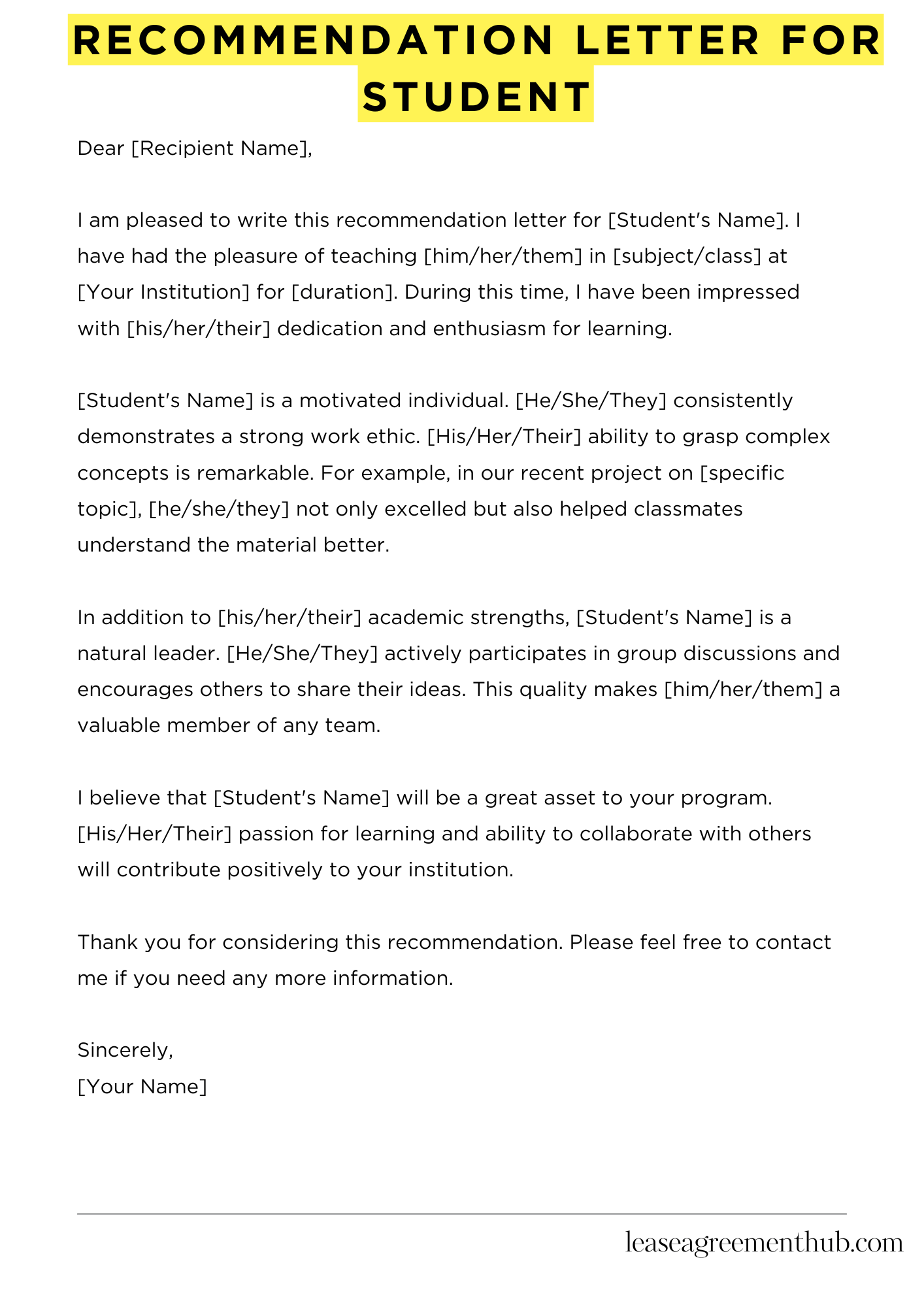A recommendation letter for a student is a written endorsement from a teacher, counselor, or mentor. Its purpose is to highlight the student’s skills, achievements, and character. These letters are often required for college applications, scholarships, or job opportunities. They provide insight into the student’s abilities and potential.
In this article, we will share various templates and examples of recommendation letters for students. These samples will help you craft a compelling letter that reflects the student’s strengths. Whether you need a letter for college admission or a scholarship, we’ve got you covered.
Writing a recommendation letter can be challenging. Our goal is to make this process easier for you. With our templates, you can quickly create a personalized letter that stands out. Let’s dive in and explore these helpful resources.
Recommendation Letter For Student
[Your Name]
[Your Position]
[Your Institution]
[Your Address]
[City, State, Zip Code]
[Email Address]
[Phone Number]
[Date]
[Recipient Name]
[Recipient Position]
[Recipient Institution]
[Recipient Address]
[City, State, Zip Code]
Dear [Recipient Name],
I am pleased to write this recommendation letter for [Student’s Name]. I have had the pleasure of teaching [him/her/them] in [subject/class] at [Your Institution] for [duration]. During this time, I have been impressed with [his/her/their] dedication and enthusiasm for learning.
[Student’s Name] is a motivated individual. [He/She/They] consistently demonstrates a strong work ethic. [His/Her/Their] ability to grasp complex concepts is remarkable. For example, in our recent project on [specific topic], [he/she/they] not only excelled but also helped classmates understand the material better.
In addition to [his/her/their] academic strengths, [Student’s Name] is a natural leader. [He/She/They] actively participates in group discussions and encourages others to share their ideas. This quality makes [him/her/them] a valuable member of any team.
[Student’s Name] is also involved in [extracurricular activities or volunteer work]. This involvement shows [his/her/their] commitment to the community and personal growth. [He/She/They] balances [his/her/their] studies with these activities effectively.
I believe that [Student’s Name] will be a great asset to your program. [His/Her/Their] passion for learning and ability to collaborate with others will contribute positively to your institution.
Thank you for considering this recommendation. Please feel free to contact me if you need any more information.
Sincerely,
[Your Name]

How to Write Recommendation Letter For Student
Understanding the Purpose of a Recommendation Letter
A recommendation letter is a crucial document that supports a student’s application for college, scholarships, or jobs. It provides insight into the student’s abilities, character, and achievements. This letter can significantly impact the decision-makers, making it essential to write it thoughtfully.
Gather Relevant Information
Before you start writing, collect information about the student. This includes their academic achievements, extracurricular activities, and personal qualities. Talk to the student to understand their goals and what they hope to achieve with the recommendation. The more details you have, the better your letter will be.
Structure Your Letter Effectively
A well-structured letter makes it easier for the reader to understand your message. Start with a formal greeting, followed by an introduction that states your relationship with the student. Then, move on to the body of the letter, where you highlight the student’s strengths and provide specific examples. Finally, conclude with a strong endorsement and your contact information.
Be Specific and Honest
When writing about the student, use specific examples to illustrate their skills and character. Instead of saying they are hardworking, mention a project where they showed dedication. Honesty is also crucial. If you cannot fully endorse the student, it is better to decline the request than to write a lukewarm letter.
Proofread and Edit
Once you have completed the letter, take time to proofread and edit it. Look for grammatical errors, awkward phrasing, or unclear statements. A polished letter reflects well on both you and the student. Ensure that the tone is positive and the content is concise, making it easy for the reader to grasp the student’s qualities quickly.
Related: